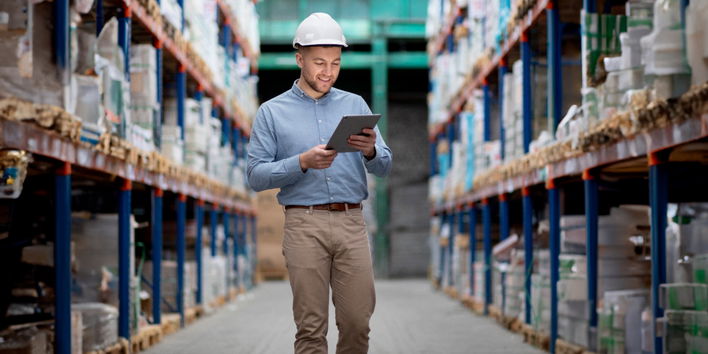- Transformation
- 15 min read
- January 2025
How Digital Transformation in Logistics Drives Growth
Key Takeaways
The logistics industry is evolving. How can digital transformation help you stay ahead?
Global supply chains are becoming more complex, customer expectations are rising, and the pressure to deliver faster, smarter, and more efficiently is higher than ever. Yet, many logistics companies still rely on outdated systems, struggling to keep pace with market demands.
With the logistics market projected to reach $14.08 trillion by 2028, the industry is full of opportunities—but also new challenges. 61% of logistics companies say legacy processes are their biggest hurdle, leading to slower deliveries, rising costs, and declining customer loyalty.
That's where digital transformation comes in. Companies leveraging real-time delivery tracking, AI-driven automation, IoT connectivity, and predictive analytics are achieving greater speed, efficiency, and transparency, transforming their logistics operations for long-term growth.
In this blog, we'll explore how digital transformation is reshaping logistics, eliminating inefficiencies, and helping businesses drive profitability in a competitive landscape. Whether you’re just starting to explore logistics innovation or looking to refine your strategy, this guide will provide the key insights and actionable steps you need to stay ahead.
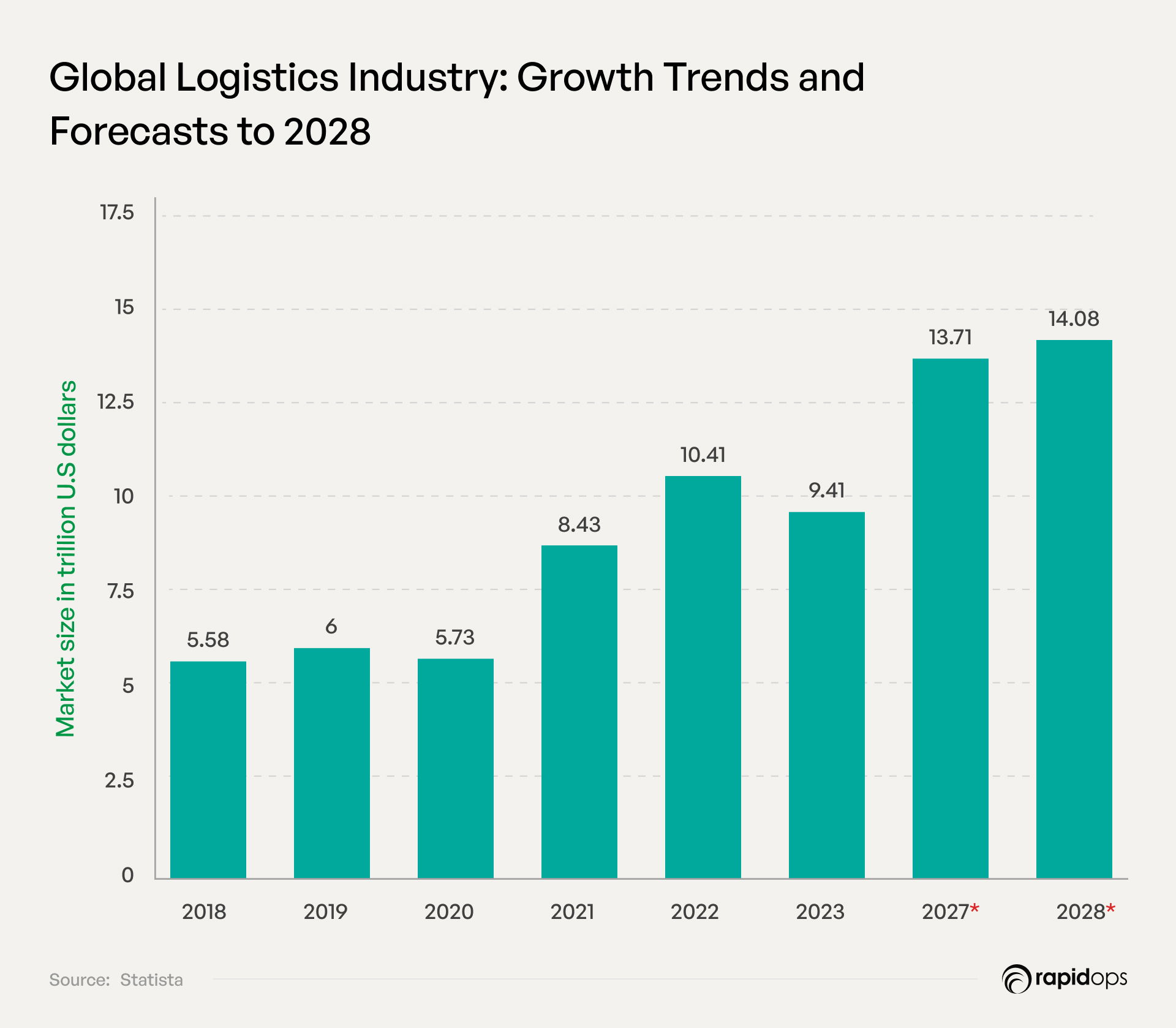
The Strategic Role of Digital Transformation in Logistics
Digital transformation in logistics is revolutionizing the industry by integrating data, streamlining operations, and transforming logistics from a support function into a powerful growth engine. By leveraging advanced technologies like AI, IoT, and automation, businesses are redefining how supply chains operate, making them smarter, faster, and more resilient.
What Digital Transformation Does in Logistics
- Integrates Data for Smarter Decisions: Real-time data from IoT sensors and AI analytics enhances visibility across supply chains, enabling proactive decision-making and reducing inefficiencies.
- Streamlines Operations: Automation in warehouses, AI-driven route optimization, and predictive maintenance eliminate bottlenecks, cut errors, and improve overall efficiency.
- Enhances Customer Experiences: With real-time tracking, faster deliveries, and personalized options, digital tools meet modern customer demands, fostering loyalty and satisfaction.
- Optimizes Costs: Technologies like route optimization and inventory management reduce operational expenses, fuel consumption, and waste.
- Strengthens Resilience: By leveraging digital tools, companies can anticipate disruptions, adapt to market changes, and ensure business continuity.
Digital transformation empowers logistics companies to optimize operations and unlock sustainable growth. The future is digital; those who embrace it will thrive, while others risk falling behind.
Key Drivers of Digital Transformation in Logistics
The logistics industry is evolving rapidly, driven by technological advancements, shifting customer expectations, and the need to navigate complex global markets. Digital transformation has emerged as the answer to these challenges, enabling businesses to stay competitive, efficient, and resilient. Here are the key drivers fueling this transformation.
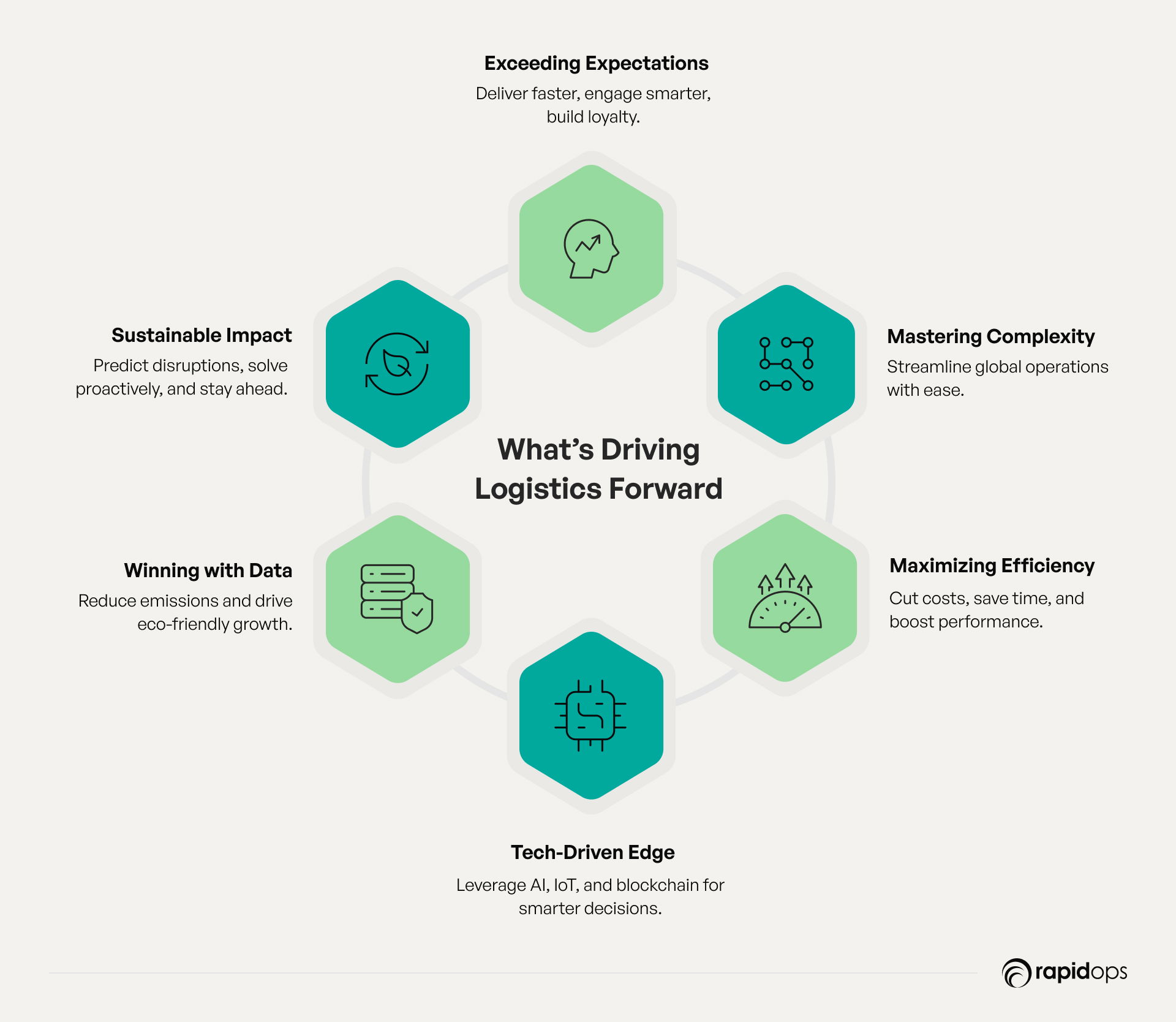
1. Evolving Customer Expectations
- Speed and Transparency: Customers demand rapid deliveries with end-to-end visibility. Digital tools like IoT-enabled tracking and real-time updates enhance transparency, ensuring superior customer satisfaction.
- Personalization: Customized delivery solutions such as same-day or scheduled delivery options are vital for meeting modern consumer needs.
2. Increasing Supply Chain Complexity
- Global Expansion: With supply chains spanning continents, the need for seamless coordination between suppliers, manufacturers, and distributors is crucial. Technologies like blockchain provide secure and transparent data sharing.
- Demand Unpredictability: Fluctuating consumer demand necessitates predictive analytics and dynamic inventory management to minimize stockouts or overstocking.
3. Cost Reduction and Efficiency
- Automation: AI and robotics streamline warehouse operations, reducing reliance on manual processes and improving accuracy in tasks like sorting, packing, and shipping.
- Route Optimization: Algorithms powered by AI minimize fuel consumption and optimize delivery times, significantly reducing operational costs.
4. Advanced Technological Integration
- AI and Machine Learning: These technologies enable predictive maintenance, demand forecasting, and operational decision-making, improving overall efficiency.
- IoT Ecosystem: IoT sensors monitor shipment conditions and vehicle performance in real time, ensuring better resource utilization and reduced downtime.
- Blockchain: Secure and tamper-proof records provide transparency in supply chain operations, fostering trust among stakeholders.
5. Sustainability Imperatives
- Eco-Friendly Operations: Digital tools help optimize delivery routes, reduce fuel consumption, and lower emissions, aligning with global sustainability goals.
- Reverse Logistics: Technologies enable efficient management of product returns and recycling, contributing to circular supply chain models.
6. Data as a Strategic Asset
- Real-Time Analytics: Access to live data enables businesses to make informed decisions, whether adjusting inventory or predicting supply chain disruptions.
- Proactive Problem-Solving: Insights derived from data analytics allow for the timely identification and resolution of operational challenges.
By addressing these drivers, digital transformation equips logistics companies to streamline operations, enhance customer experiences, and build resilience, enabling long-term success in a highly competitive market.
The Benefits of Digital Transformation in Logistics
Digital transformation in logistics isn’t just about moving goods; it’s about creating momentum that drives efficiency, agility, and growth. By leveraging AI, automation, and predictive insights, you gain smarter operations, faster adaptability, and reduced risks. Explore these benefits and how they can create a competitive edge for your business.
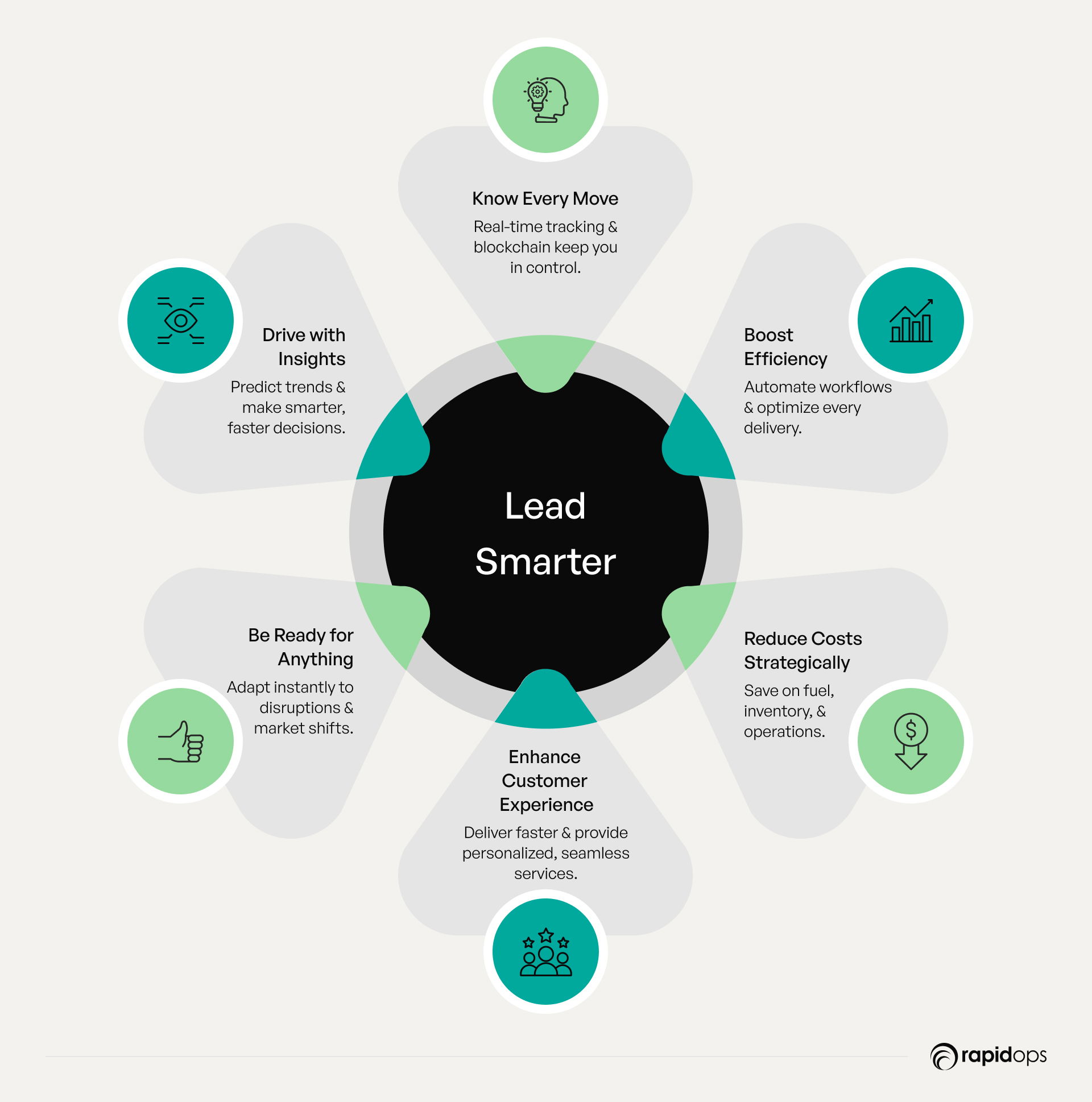
1. Enhanced Supply Chain Visibility
Visibility across logistics and distribution is critical for operational success. Traditional systems often lack the transparency needed to monitor shipments in real-time, but digital transformation bridges this gap.
- IoT Sensors and Tracking: IoT-enabled devices offer real-time updates on shipment location, temperature, and handling conditions. For example, imagine a global shipping company that uses IoT sensors to track perishable goods, ensuring timely interventions to prevent spoilage.
- Blockchain for Transparency: Blockchain creates secure, immutable records of transactions, ensuring data accuracy and accountability across the supply chain.
2. Improved Operational Efficiency
Manual processes and inefficiencies cost time and money. Digital transformation replaces outdated systems with streamlined workflows powered by automation and AI.
- Warehouse Automation: Robotic systems handle picking, packing, and inventory management with precision, reducing human error and speeding up operations.
- AI-Driven Route Optimization: AI analyzes data to determine the most efficient delivery routes, saving fuel and time. For instance, a logistics company using AI-based optimization saw a 20% reduction in delivery times.
- Predictive Maintenance: Sensors on vehicles and machinery predict maintenance needs, avoiding costly breakdowns and delays.
3. Cost Reduction
Digital tools address key cost drivers in logistics, allowing businesses to optimize resources and save money.
- Fuel Savings: Advanced route optimization minimizes travel distances, cutting fuel consumption significantly.
- Resource Efficiency: Automation in inventory management reduces storage costs by preventing overstocking or understocking.
4. Enhanced Customer Experience
Customers now expect speed, transparency, and customization in logistics services. Digital transformation helps meet these expectations effectively.
- Real-Time Tracking: IoT and GPS technologies provide customers with accurate, live updates on their shipments, enhancing trust and satisfaction.
- Faster Deliveries: Automated processes and AI-driven solutions minimize delays, ensuring timely deliveries.
- Personalized Services: Data-driven insights enable businesses to offer tailored delivery options, such as preferred delivery windows or eco-friendly packaging.
5. Increased Agility and Resilience
The logistics industry is prone to disruptions, from natural disasters to market shifts. Digital transformation equips businesses to adapt quickly.
- Data-Driven Adaptability: Real-time analytics help companies respond to sudden changes in demand or supply chain disruptions.
- Scenario Simulation: AI-powered tools simulate potential disruptions, enabling better preparation and risk mitigation.
6. Smarter Decision-Making
Real-time data and advanced analytics empower businesses to make informed decisions with greater speed and accuracy.
- Predictive Analytics: AI identifies patterns in historical and real-time data to forecast demand, optimize routes, and minimize risks.
- Planning and Strategy: Data visualization tools enhance planning for inventory, staffing, and fleet management.
Core Technologies Driving Logistics Transformation
The logistics industry is embracing a digital shift through advanced technologies that enhance operations, efficiency, and competitiveness. These innovations are reshaping how goods are moved, tracked, and delivered, driving growth in a rapidly evolving market. See how technology is truly driving logistics transformation and boosting business success.
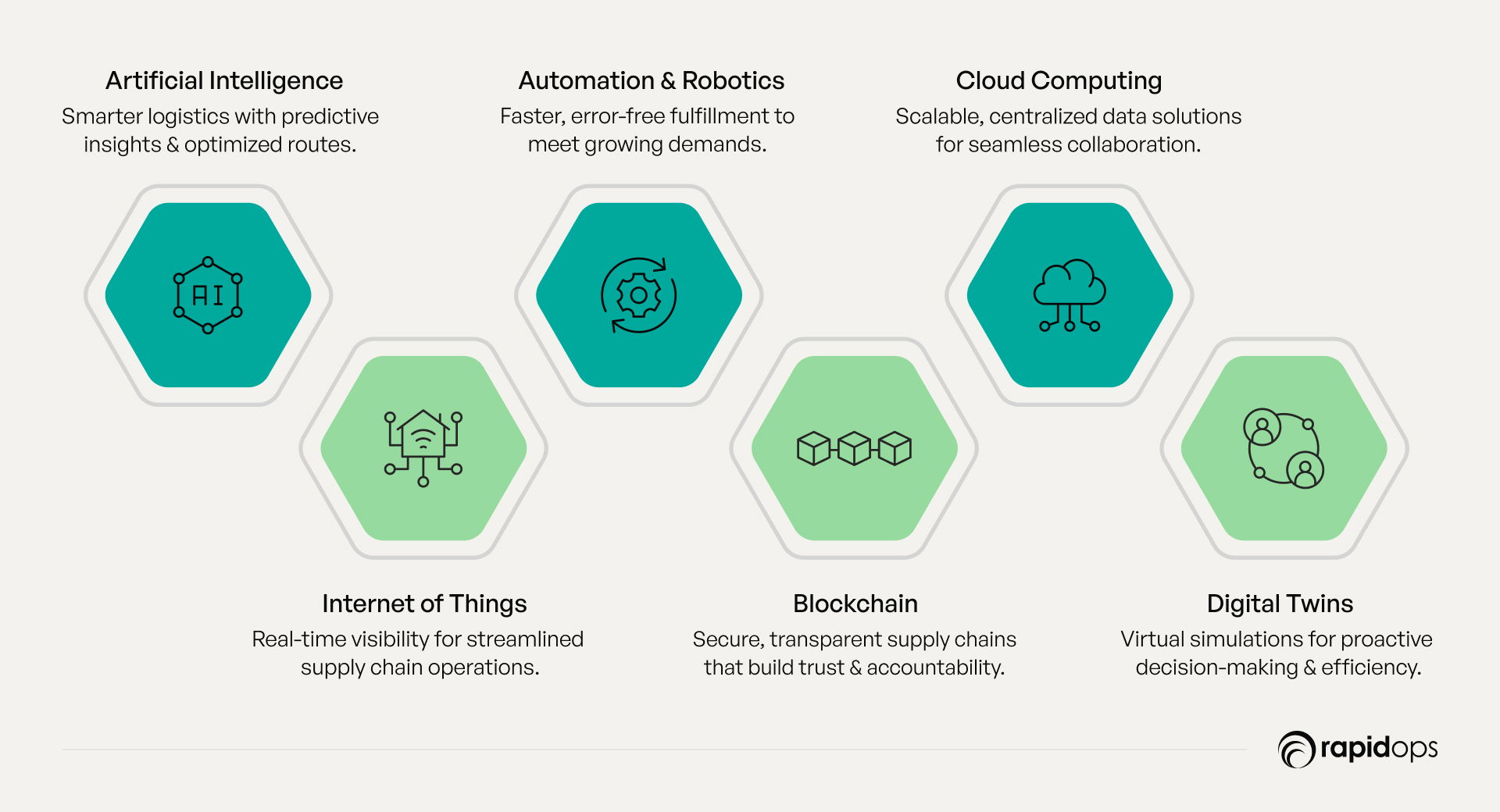
1. Artificial Intelligence (AI): Smarter Decisions for Better Logistics
AI uses data and advanced algorithms to help businesses predict outcomes and make smarter decisions. Think of it as a digital assistant that continuously learns and adapts to improve operations.
How It Works in Logistics
- Predictive Maintenance: AI predicts when machinery or vehicles might fail, preventing costly breakdowns.
- Route Optimization: AI calculates the fastest and most efficient delivery routes by analyzing traffic, weather, and delivery windows.
- Demand Forecasting: By analyzing trends, AI helps align inventory with customer needs, avoiding overstock or stockouts.
Impact
With AI, logistics companies can minimize disruptions, reduce costs, and deliver faster, more reliable services. It’s not just about saving money—it’s about creating a smarter, more agile operation.
2. Internet of Things (IoT): Real-Time Visibility Across Operations
IoT connects devices, sensors, and systems to share real-time data. Imagine a network that constantly monitors your supply chain and alerts you to potential issues before they become problems.
How It Works in Logistics
- Shipment Tracking: Sensors on packages or vehicles provide live updates, so you always know where your goods are.
- Warehouse Monitoring: IoT devices track inventory levels and conditions, ensuring items are stored properly.
- Fleet Management: Monitors vehicle performance and fuel usage to keep operations efficient.
Impact
IoT helps businesses achieve transparency, improve reliability, and respond quickly to changes. This level of visibility enhances customer trust and streamlines operations.
3. Automation and Robotics: Speed and Precision at Scale
Automation and robotics handle repetitive tasks, increasing speed and accuracy. From automated picking in warehouses to robotic sorting systems, these technologies ensure consistent, high-quality results.
How It Works in Logistics
- Warehouse Automation: Robots pick, pack, and sort items faster than human workers, reducing errors and speeding up fulfillment.
- Robotic Sorting: Sort packages with precision, making the distribution process seamless.
- Last-Mile Delivery: Drones and autonomous vehicles enhance delivery speed and reduce labor costs.
Impact
Automation and robotics enable businesses to scale operations, meet growing demand, and maintain high service standards—all while cutting costs.
4. Blockchain: Building Trust and Security in Supply Chains
Blockchain is a secure digital ledger that records every transaction. It’s like a tamper-proof record book that everyone in your supply chain can trust.
How It Works in Logistics
- Supply Chain Transparency: Track every step of your supply chain, ensuring goods are authentic and delivered as promised.
- Fraud Prevention: Blockchain makes it nearly impossible to alter or fake records, reducing fraud.
- Smart Contracts: Automate agreements between suppliers and customers, ensuring faster and more reliable transactions.
Impact
Blockchain fosters trust and accountability in retail, manufacturing, and logistics by ensuring product traceability, improving quality control, and providing secure, real-time tracking, streamlining operations, and strengthening supply chain relationships.
5. Cloud Computing: Flexibility and Scalability at Your Fingertips
Cloud computing stores data and applications on remote servers, making them accessible from anywhere. It’s like having a central hub for all your logistics data.
How It Works in Logistics
- Centralized Data Management: Combine data from different sources into one platform for better decision-making.
- Remote Collaboration: Teams can access and update logistics data in real time, no matter where they are.
- Scalable Solutions: Easily adapt to changing demands, such as peak seasons, without overhauling infrastructure.
Impact
Cloud computing simplifies logistics operations, improves collaboration, and supports growth by providing the flexibility businesses need to adapt to changing markets.
6. Digital Twins: Driving Logistics Efficiency with Real-Time Data
Digital twins are virtual replicas of physical assets, systems, or processes that simulate real-world operations. They integrate real-time data to provide insights for optimization and predictive analysis, allowing businesses to improve performance and decision-making.
How It Works in Logistics
- Real-time Monitoring: IoT sensors track the performance and location of assets, providing live updates.
- Supply Chain Visibility: Creates a virtual model of the supply chain for full operational transparency.
- Predictive Analytics: Analyzes data trends to predict disruptions like delays or stockouts, enabling proactive actions.
- Simulation and Optimization: Tests scenarios to optimize routes, layouts, and inventory management.
- Improved Decision-Making: Data-driven insights enable smarter, faster operational decisions.
Impact
Digital twins drive logistics transformation by enhancing efficiency, reducing costs, improving customer service, and enabling data-driven, proactive decision-making across the entire supply chain.
Why These Technologies Matter for You
Each of these technologies offers practical solutions to everyday logistics challenges, from ensuring on-time deliveries to reducing costs and improving customer satisfaction. By adopting these innovations, businesses can not only keep up with the competition but also build a logistics network that thrives in an unpredictable market.
Challenges of Digital Transformation in Logistics
Digital transformation in logistics offers unparalleled potential to streamline operations, improve efficiency, and meet growing customer demands. However, implementing these changes comes with a unique set of challenges that require careful navigation. Here are the most pressing challenges businesses face during logistics digital transformation.

1. Resistance to Change
Digital transformation often encounters resistance from within the organization.
- Employee Pushback: Employees may fear job displacement or feel overwhelmed by the need to learn new technologies.
- Stakeholder Hesitation: Decision-makers and partners might resist changes due to concerns about disruptions or a lack of confidence in the proposed technologies.
- Cultural Barriers: Organizations with rigid hierarchies or traditional workflows may struggle to adapt to a digital-first approach.
2. Cost Constraints
Implementing digital transformation initiatives requires significant investment, and cost is a major obstacle for many businesses.
- High Upfront Costs: The initial expenses for hardware, software, infrastructure upgrades, and training can be prohibitive.
- Uncertain ROI: Decision-makers may hesitate due to the lack of immediate or guaranteed returns, making it harder to justify spending.
- Budget Limitations: Smaller companies often face difficulty competing with larger enterprises that have the resources to invest heavily in advanced solutions.
3. Vendor and Technology Selection
The process of selecting the right technology and vendors is one of the most daunting challenges.
- Overwhelming Options: With a wide variety of solutions available, ranging from AI and IoT to blockchain and automation tools, businesses struggle to identify which technologies align with their specific needs and long-term goals.
- Scalability Concerns: Many solutions lack scalability, forcing companies to reinvest in new systems as they grow.
- Compatibility Issues: Integrating new technologies with existing systems often leads to disruptions, delays, or operational inefficiencies.
4. Supply Chain Complexity
Logistics supply chains are inherently complex, involving numerous stakeholders, systems, and geographic locations.
- Fragmented Systems: Data silos across different parts of the supply chain create barriers to end-to-end visibility and decision-making.
- Stakeholder Coordination: Ensuring seamless collaboration between suppliers, manufacturers, and logistics providers is difficult due to varying technologies and standards.
- Global Operations: Managing global supply chains introduces challenges such as language barriers, varying regulations, and inconsistent infrastructure.
5. Lack of Skilled Workforce
Adopting and managing advanced digital tools requires specialized skills, which are often in short supply.
- Skills Gap: The logistics workforce may lack expertise in areas such as data analytics, AI, IoT, and blockchain.
- Training Challenges: Upskilling employees is resource-intensive and time-consuming, often delaying implementation timelines.
- Dependence on External Expertise: Companies without in-house talent may become overly reliant on third-party vendors or consultants.
6. Integration Challenges and Timelines
Integrating modern technologies into legacy systems is one of the most technically challenging aspects of digital transformation.
- Legacy Systems: Outdated infrastructure often struggles to support modern technologies, requiring expensive upgrades or replacements.
- Complex Implementations: Coordinating the deployment of interconnected technologies across multiple operations leads to prolonged timelines.
- Downtime Risks: System upgrades or replacements can cause operational downtime, disrupting day-to-day activities.
The Future of Logistics: Emerging Trends to Watch
The logistics industry is transforming with innovations like Hyperloop, robotics, and green hydrogen-powered trucks, enabling businesses to drive efficiency, meet sustainability goals, and exceed customer expectations in a competitive market.
1. Hyperloop Freight Transport
Hyperloop technology, with its potential for high-speed and energy-efficient transport, is poised to redefine global logistics. By being capable of moving goods at over 600 mph, Hyperloop can cut long-distance delivery times by up to 75%.
For instance, Virgin Hyperloop’s pilot projects aim to reduce freight costs while improving supply chain speed. Businesses that integrate Hyperloop into their logistics strategy can gain a competitive edge by offering faster delivery at reduced operational costs, paving the way for global market expansion.
2. Autonomous Delivery Hubs
Autonomous delivery hubs powered by AI and robotics are set to revolutionize urban logistics by optimizing sorting, loading, and distribution. As urban populations grow, these hubs help manage high delivery volumes while reducing costs and human dependency.
DHL’s pilot autonomous hubs, for example, have reduced sorting times by 30%. By investing in this trend, businesses can handle increasing delivery demands efficiently, ensuring scalability and customer satisfaction.
3. Swarm Robotics
Inspired by insect swarms, swarm robotics enables collaborative work among multiple robots to enhance warehouse efficiency. These robots can adapt to dynamic conditions, reducing order processing time by up to 40%.
Amazon has already adopted swarm robotics to automate picking and packing, cutting delivery times significantly. Businesses that implement swarm robotics can handle seasonal spikes in demand while improving overall operational performance and driving revenue growth.
4. Green Hydrogen-Powered Trucks
Green hydrogen-powered trucks are transforming long-haul freight logistics by offering a zero-emission alternative. These trucks provide faster refueling than electric alternatives and lower operational costs over time. Nikola Corporation, for instance, is developing hydrogen-powered trucks that can travel up to 500 miles per fill.
Early adopters of hydrogen-powered trucking can achieve sustainability goals while positioning themselves as leaders in eco-friendly logistics, attracting environmentally conscious customers and partners.
Case Studies: Logistics Companies Leading the Digital Transformation
Is your logistics strategy ready for transformation? Digital transformation is crucial for improving efficiency and profitability. How have leaders like DHL, FedEx, and UPS used AI, IoT, and robotics to optimize operations? Let’s explore key case studies and practical takeaways.
DHL: Harnessing AI, IoT, and Robotics for Seamless Logistics
DHL, a global logistics leader, has been at the forefront of digital transformation. By incorporating technologies like artificial intelligence (AI), the Internet of Things (IoT), and robotics, DHL has revolutionized its logistics processes to meet evolving market demands.
What They Did
- AI for Predictive Analytics: DHL uses AI-driven analytics to forecast demand, optimize supply chain operations, and reduce inefficiencies. This ensures faster delivery times and cost savings.
- IoT for Real-Time Tracking: IoT sensors provide DHL with live updates on shipment conditions, such as temperature, humidity, and location, ensuring sensitive goods like pharmaceuticals are transported safely.
- Robotics in Warehousing: Automated guided vehicles (AGVs) and robotic arms are used in DHL’s warehouses to improve picking and sorting accuracy, significantly increasing operational efficiency.
Impact
- Reduced delivery times by streamlining warehouse operations with robotics.
- Enhanced customer satisfaction with real-time shipment tracking.
- Achieved cost savings through optimized routing and predictive analytics.
Key Takeaway
DHL’s use of AI, IoT, and robotics demonstrates how integrating advanced technologies can transform logistics into a highly efficient, customer-centric operation.
FedEx: Revolutionizing Shipment Monitoring with IoT
FedEx has redefined how logistics companies monitor shipments with its SenseAware platform, powered by IoT. The platform provides real-time visibility into the location and condition of goods in transit, addressing critical challenges like lost or delayed shipments.
What They Did
- IoT-Enabled SenseAware: The platform uses IoT devices to monitor shipments' temperature, light exposure, and location, ensuring that time-sensitive goods such as healthcare products and perishable items are delivered in perfect condition.
- Proactive Issue Resolution: SenseAware notifies stakeholders of potential disruptions, allowing immediate intervention to prevent delays or spoilage.
- Data-Driven Insights: The platform generates valuable analytics on delivery patterns, helping FedEx optimize its logistics processes.
Impact
- Reduced shipment losses and delays through proactive monitoring.
- Improved service reliability, boosting customer trust and retention.
- Enabled better planning and decision-making using data insights.
Key Takeaway
FedEx’s SenseAware platform showcases how IoT can transform logistics by providing unparalleled visibility and control, ensuring reliability and efficiency in supply chains.
Learning from the Leaders
DHL and FedEx are not just leveraging technology; they are setting the standard for how logistics companies can thrive in an increasingly complex and competitive environment. Their strategic adoption of digital transformation showcases the direct benefits of investing in advanced technologies: enhanced efficiency, improved customer satisfaction, and long-term growth.
For businesses aiming to replicate this success, the path forward lies in identifying key pain points, selecting the right technologies, and integrating them strategically into logistics operations. By doing so, you can position your organization as a leader in the evolving logistics landscape.
Empowering Your Logistics Transformation: Lead the Future
Logistics transformation goes beyond adaptation; it's about leading change. By rethinking operations with innovation, agility, and a focus on delivering exceptional customer value, businesses can stay ahead in a rapidly evolving world. Strategic leaders are harnessing technologies and data-driven insights to overcome challenges, streamline processes, and create growth opportunities.
However, navigating this transformation can feel complex, and knowing where to start is key. That's where we come in. At Rapidops, we partner with you to turn challenges into opportunities. With over a decade of expertise, we design scalable logistics systems powered by actionable insights and cutting-edge technologies. From optimizing operations to achieving sustainability and driving measurable results, our tailored solutions align with your business goals.
To take the next step in optimizing your logistics processes, schedule a strategy call with us today. Together, we’ll explore how Rapidops can help increase efficiency, unlock growth opportunities, and build a resilient, future-ready logistics operation that delivers real value.
Frequently Asked Questions
How do digital twins improve decision-making in logistics?
How can digital transformation reduce delays in the supply chain?
How can digital transformation enhance customer communication in logistics?
What are the most critical KPIs to track during a digital transformation in logistics?
What are the major ways of transformation in the logistics industry?
What’s Inside
- The Strategic Role of Digital Transformation in Logistics
- Key Drivers of Digital Transformation in Logistics
- The Benefits of Digital Transformation in Logistics
- Core Technologies Driving Logistics Transformation
- Challenges of Digital Transformation in Logistics
- The Future of Logistics: Emerging Trends to Watch
- Case Studies: Logistics Companies Leading the Digital Transformation
- Empowering Your Logistics Transformation: Lead the Future
